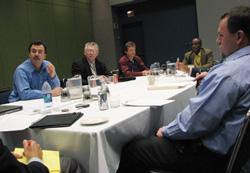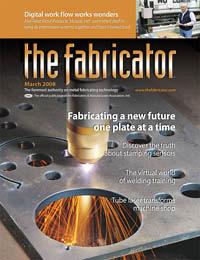Editor-in-Chief
- FMA
- The Fabricator
- FABTECH
- Canadian Metalworking
Categories
- Additive Manufacturing
- Aluminum Welding
- Arc Welding
- Assembly and Joining
- Automation and Robotics
- Bending and Forming
- Consumables
- Cutting and Weld Prep
- Electric Vehicles
- En Español
- Finishing
- Hydroforming
- Laser Cutting
- Laser Welding
- Machining
- Manufacturing Software
- Materials Handling
- Metals/Materials
- Oxyfuel Cutting
- Plasma Cutting
- Power Tools
- Punching and Other Holemaking
- Roll Forming
- Safety
- Sawing
- Shearing
- Shop Management
- Testing and Measuring
- Tube and Pipe Fabrication
- Tube and Pipe Production
- Waterjet Cutting
Industry Directory
Webcasts
Podcasts
FAB 40
Advertise
Subscribe
Account Login
Search
Recruit, train, and retain
The FABRICATOR's Editorial Advisory Board came together to share observations and discuss ways to attract workers to the world of manufacturing.
- By Dan Davis
- March 11, 2008
- Article
- Shop Management

The FABRICATOR's Editorial Advisory Board meets to discuss ways to find new talent and keep them interested in manufacturing as a career choice.
Time has passed, but the times haven't changed that much. A little over two years ago The FABRICATOR's Editorial Advisory Board engaged in a roundtable discussion at the 2005 FABTECH® International & AWS Welding Show in Chicago. The subject that day centered around what industry and education could do to prepare younger workers for the opportunities within manufacturing companies as the baby boomers retire.
Last November we invited the Editorial Advisory Board back for 2007's largest metal fabricating and forming show in the U.S. This time we focused the board's attention on ways to recruit and retain employees. Everyone realizes that most of the country struggles to find good skilled workers, and everyone probably can use some tips to help them through these struggles.
The FABRICATOR Editorial Advisory Board members involved in this discussion were:
- Charles Caristan, business development manager, Air Liquide Industrial U.S. LP, Houston, an industrial gas supplier
- Matt Gehman, president and general manager, Metal Locking Service, Buffalo, N.Y., a specialist in cast-iron repair
- Matt Kalina, director of marketing, LAI Southwest, a laser and waterjet job shop in Phoenix
- Muammer Koç, assistant professor and director, Center for Precision Forming, Virginia Commonwealth University, Richmond, Va.
- Subramaniam Manivannan, launch readiness specialist, Ford Motor Co., Dearborn, Mich.
- Gary Morphy, project engineer, Synthesis Engineering Solutions, a Cambridge, Ont.-based consultancy to manufacturing companies
- Roger Schulz, purchasing manager, Monroe Truck Equipment, Snow and Ice Div., Monroe, Wis.
Following is an edited transcript of their discussion that occurred at the 2007 FABTECH International & AWS Welding Show in Chicago.
What do you or your companies do to get people interested in working for you or get them into manufacturing?
Roger Schulz:We look at companies in the area that have had a reduction in force. They might have similar types of products or employees with similar skills that we are looking for.
We have had some success doing this.
Muammer Koç:What some of the companies in Virginia are doing is inviting college students to their plants and giving them tours. It shows them what they can do and how they can get involved in manufacturing. The companies have found it to be quite successful.
Subramaniam Manivannan:Ford in Michigan has experimented with going out and getting people from different industries who might be considered "fresh-minded."For example, they may have found people from construction, and they have good technical backgrounds and might bring different ideas—even if the construction skills aren't directly needed.
Matt Gehman:We're part of a trade association [Machine Shops of Western New York], and one of the things that we have tried to do in getting the younger generation interested in manufacturing is to provide small scholarships and also toolkits, which contain $300 to $400 in trade tools that they can use. We are distributing them to the local vocational schools, and that seems to be where we get the best response. We try to pique their interest and give them some sort of direction.
I think that a lot of these people don't have an inkling about what these places can do and how they do it. So this gets their mind going a little bit.

"...Career development allows people to be more fulfilled and feel they have a future with the company." -Charles Caristan, Air Liquide Industrial U.S. LP
Schulz:We also have relationships with local vocational institutions, but so few kids are involved in those classes today. It doesn't produce all the people that are needed for welding and other fabrication jobs.
Anyone else working with local educational institutions?
Manivannan:Look at Focus: HOPE in Michigan. It's very successful. They have their own manufacturing capability with CNC machines and other manufacturing equipment. They are very successful in working with local youngsters and teaching them manufacturing skills. It could be a model for others to follow.
And it is supported by both public and private money.
Koç:I think engaging with the schools, whether they are high schools or vocational schools, by the companies or by the trade associations makes a big difference. The students appreciate it. The teachers like it a lot. They need this kind of educational and moral support. If an engineer takes time to spend with these people, it makes a big difference.
As an engineering school in Virginia, we are trying to build up students' interest in engineering. How do we do that? We go to middle schools, high schools, and take benchtop exhibits or tabletop machines to show them what they can do and get them interested.
Last year I worked with different teachers. We talked about developing assignments around fuel cell manufacturing or lightweight-vehicle design, and we developed some modules for them to use with their students. The ultimate goal is to get the students interested in engineering and science so they enter this area of study.
Manivannan:In another example I'm familiar with, vocational training is being made a larger part of the educational process. Students at the school actually work in a kitchen, and once a week you can go and eat there.
The same thing is applied to other areas. If you are in a mechanical class, you can bring your car in and fix it. If you are in the tool shop, you can bring in a lawn mower and get it fixed. It's for grades nine through 12. The students get a job right out of school.
Matt Kalina:I think the relationships between the trade associations and the community colleges are critical. If there can be a strong connection between the trade associations and the placement offices of the community colleges, prospective students, especially upon graduation, can be shown that there is a multitude of good-paying, high-skilled jobs in manufacturing. In return, that's going to position that particular department of the community college or other educational facility as a strong one in comparison to other departments [that aren't placing students in jobs].
I'm not sure if those relationships exist, but that's why a lot of these students go to a particular school. They need to get through the training quickly, and they want to find work.

"...We're almost always starting from ground zero [with employees] with no skills, no ability, and 100 percent company-sponsored training." -Matt Gehman, Metal Locking Service
Is there anything that you do during hiring or have heard about that helps weed out bad job candidates or provides more insight into employees you might be hiring?
Manivannan:The one that I've heard that is successful is a simulation type of interview. The candidate can actually work through the steps involved in making a part.
The other thing that I've heard is a test to see if the candidate is just interested. Let the vocational student or whoever work at the task for an hour or an hour and a half. That way you get a hands-on look at how they react.
Kalina:We have a three-hour testing routine that includes reading comprehension, mechanical mapping, and print reading.
It's a turnoff because it's pretty grueling. But it seems to work.
Another thing I might mention is that we have had pretty good success in finding job candidates through a temp agency. When they work out, they show a great ability to stay with the company. We'll offer them a permanent position and that seems to work out.
We've been pretty selective with the temp agencies as well. When it doesn't work out, we aren't afraid to switch the temp agency.
Schulz:A good attitude and a demonstrated positive work experience with previous employers are about as good a standard to go by. If guys come in with a foul attitude, it doesn't matter what they know. They'll be a divisive force, and they'll screw up everything.
We don't have any type of pre-employment requirement for them to pass other than they be in a good physical condition. You don't have to know anything. If they are willing to learn, we'll put them through a welding class and print reading—even a basic math class.
What type of things are people doing to retain workers?
Schulz:One of the things that we've discovered over time is that not everyone is a trainer. When we assign new employees to an experienced worker, right off the bat we let them work together in close, one-on-one supervision. As they progress and the training becomes more complex, not everyone is capable of participating in training, even if they have the skills. Some people cannot communicate. So selecting the trainers is as important as the training.
Charles Caristan:It's also important to look at career development. In our company, the human resources people have developed a technical career track, so that people can grow with the company and rely on their technical skills, not necessarily follow the typical management track. This type of career development allows people to be more fulfilled and feel they have a future with the company.

"All parts of our company are required to do regular 'pass-downs' of information. It usually comes in the form of very brief e-mails and daily stand-up meetings.-Matt Kalina, LAI Southwest
Schulz:That's a good plan. When I started in purchasing more than 40 years ago, the only way to advance was to change companies.
Gehman:One of the things that we do when we hire new people is that we start them off on a two-year progressive plan. They are told from their hire date that they will have a two-year anniversary date when they have to meet certain requirements for the job. The reviews take place every six months—four reviews during the first two years.
What we have done is that when you reach that anniversary date, you'll make a minimum salary. If you do above and beyond what was required, then you can earn more than that. So we are starting them off with a defined point, giving them an established goal to get to after two years. You get four evaluations in between there. So what we explain to them is that if you track and do well, there will be a nice progressive line up to the top, and then if you show immediate ability and latch on to the training, then after that first evaluation, you'll see a much higher increase in salary after six months to reward the effort. So there's an initial adjustment so that people aren't discouraged and look for the greener pasture somewhere else.
Conversely, if a guy comes in and thinks he has his foot in the door and does just enough to get by, that first evaluation is pretty flat. And if it continues to be flat through the whole two-year probation period, then we can take action.
Along with that, we also ask new hires to do a self-evaluation. We see how that tracks with how we think people are doing. It's pretty interesting the feedback we get back on that, as you can imagine.
This is important for us because the only way we can find a skilled person is if a neighboring company closes and they are looking for work. So we're always starting from ground zero with no skills, no ability, and 100 percent company-sponsored training. That's the way we keep them enthusiastic.
After that first two years, then they are really on their own to work with their mentors and make a career out of it.
We're a union shop, so we've tied that into our contract. So they think that it's a win-win for them. We have a lot of latitude that first two years.
What we find is that they drop out between the hire date and the six-month evaluation. If they make it past two years, we keep almost 100 percent of them.
What that gives us, though, is a group of guys that have been with the company 10 years or more and another group of guys that are in the six-month to three-year range of experience. That's a big gap and is almost like two different worlds.
Manivannan:At the Ford plants, the company is pushing recognition. At the morning meetings or the town hall meetings, management is passing out "job well done"plaques or certificates of appreciation. So they can expect a vice president or a plant manager to present them with the award and shake their hand.
During difficult times like these, we are doing whatever we can to recognize people.
Koç:It all comes down to human psychology. You want to be treated well and you should treat other people well: pay raises and recognition.
Manivannan:Some places are doing the "stay interview,"which is the opposite of an exit interview. You can find out what negative and positive things might be on the minds of employees.
Schulz:I think one of the big questions is, How do you keep these people interested when they might be doing the same task day after day?
Manivannan:Rotation.
Schulz:You have to have cross-functional training.
Manivannan:In the automotive industry, workers move from job to job because of ergonomic reasons. That happens day after day.
Schulz:I once visited a plant in Japan where the plant manager was very proud because they didn't have menial jobs. When a job was deemed too menial, too boring, too repetitive, or caused things to slow down, they designed a machine to do the job. They only had jobs that challenged their employees.
How do you tap the knowledge of more experienced workers? How do you get older workers to open up and share their wisdom with less experienced workers?
Koç:I have heard of a company that tried to get some of their older workers who have been with the company a long time to consult in creation of the training program. They ask them to prepare a one-day training session. So they do it for the younger employees, and they feel good about it.

"At the Ford plants, the company is pushing recognition. At the morning meetings or the town hall meetings, management is passing out 'job well done' plaques or certificates of appreciation. -Subramaniam Manivannan, Ford Motor Co.
At the same time, they have prepared printed material that they can pass out and that helps capture the knowledge.
Schulz:Video filming of work tasks benefits in a number of ways. It allows people who aren't performing the tasks for whatever reason to observe how it comes together, and they may have a creative idea for a better way to do it. Suddenly you have a new idea.
Koç:Giving people the opportunity to provide feedback makes them happy. It gives them the satisfaction that you are listening to them. It makes them work harder.
By doing that, you get them to train other people and get them to be more open in a way.
Kalina:We have definitely found that more communication works.
All parts of our company are required to do regular "pass-downs"of information. It usually comes in the form of very brief e-mails and daily stand-up meetings. We have a monthly meeting to communicate progress and open the books up, but we also reinforce that with an incentive on positive months, which gets distributed to every employee in the form of a check.
The kaizen events, we do them once in a while. Everyone is involved in 5S responsibilities, office and the shop. And once in awhile, we do team-building activities, such as going to a bowling alley.
Caristan:There was a company in the Detroit area, and it had weight-loss targets for employees. The winners got airline tickets to somewhere in the U.S. Prizes such as that sometimes work out very well.
What do you think should be done to make a manufacturing career more appealing?
Gehman:I always feel like we are backwards, that we are trying to sell our company to the job candidate rather than the job candidate trying to sell himself to us.
We are always caught in a position of trying to make the job sound interesting.

"One of the things that we've discovered over time is that not everyone is a trainer...Some people cannot communicate. So selecting the trainers is as important as the training." -Roger Schulz, Monroe Truck Equipment, Snow and Ice Div.
Kalina:I think there is good potential with a rock star type of approach to fabrication and industrial careers with companies such as Cat, John Deere, or any others that could generate the excitement that is in other industries, such as biotech or health care, both of which are hot. Certainly, it's up to the industry associations or maybe some of the larger companies to upgrade the image. It is an image problem. Maybe that's what we are talking about today.
The second tier [of manufacturing companies] is competing against each other to attract that smaller and smaller pool of qualified people. The one thing that is important for each of these companies to do is to have that human resources department—whether it's one person in a smaller company or a much larger department—and make sure that the benefits package is highly attractive and promoted during the hiring process.
Caristan:I have the privilege of traveling around the country and visiting job shop after job shop, plant after plant, mostly in metal fabrication, and I have seen everything, from top-of-the-line facilities to down-and-dirty, oily, and dark shops. You can tell the ones you want to work for and the ones you don't want to work for.
I don't know what leadership organizations such as the Society of Manufacturing Engineers or the Fabricators & Manufacturers Association could do in helping to change the image of manufacturing. It doesn't have to be oily, dirty, dark, and noisy.
About the Author

Dan Davis
2135 Point Blvd.
Elgin, IL 60123
815-227-8281
Dan Davis is editor-in-chief of The Fabricator, the industry's most widely circulated metal fabricating magazine, and its sister publications, The Tube & Pipe Journal and The Welder. He has been with the publications since April 2002.
subscribe now

The Fabricator is North America's leading magazine for the metal forming and fabricating industry. The magazine delivers the news, technical articles, and case histories that enable fabricators to do their jobs more efficiently. The Fabricator has served the industry since 1970.
start your free subscription- Stay connected from anywhere

Easily access valuable industry resources now with full access to the digital edition of The Fabricator.

Easily access valuable industry resources now with full access to the digital edition of The Welder.

Easily access valuable industry resources now with full access to the digital edition of The Tube and Pipe Journal.
- Podcasting
- Podcast:
- The Fabricator Podcast
- Published:
- 04/16/2024
- Running Time:
- 63:29
In this episode of The Fabricator Podcast, Caleb Chamberlain, co-founder and CEO of OSH Cut, discusses his company’s...
- Industry Events
16th Annual Safety Conference
- April 30 - May 1, 2024
- Elgin,
Pipe and Tube Conference
- May 21 - 22, 2024
- Omaha, NE
World-Class Roll Forming Workshop
- June 5 - 6, 2024
- Louisville, KY
Advanced Laser Application Workshop
- June 25 - 27, 2024
- Novi, MI
































